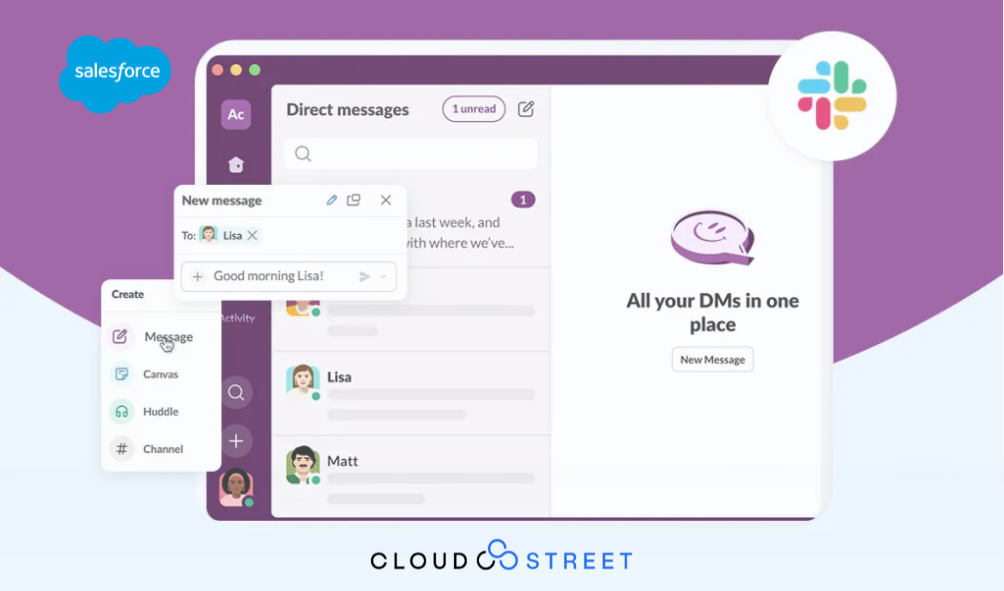
Productivity is the key to business success and Slack from Salesforce is going all-in. Top companies are more than 40 percent more productive than other companies, according to Harvard Business Review. And 71 percent of business leaders say they feel pressure to make their teams more productive.
One of the most significant ways companies improve productivity is through Artificial Intelligence (AI) and automation. Salesforce is rolling out a new update to its productivity and messaging platform, Slack, to help employees better navigate the platform. The update will also make productivity-enhancing tools more easily accessible. The rollout will occur gradually over the next few months.
“We know millions of people start and end their workday in Slack, so we took great care to ensure these improvements make it a more productive and pleasant home. The new experience helps teams stay better organized, focus on what’s important, and quickly access a growing set of tools in Slack,” says Noah Weiss, Slack’s chief product officer.
Slack helps organizations share information and ideas, breaking down silos and helping teams to collaborate. Team members can share information through audio and video clips, huddling with colleagues (audio and video calls), and adding links to work in other systems. Teams also use Slack to keep their information organized within their channels. The new design puts the capabilities within easier reach.
Key Changes
The update will give users more control over their time and allow for many ways of working. It will improve the user experience in several significant ways.
A Single View
The update will allow employees to view direct channels, apps, and direct messages in a well-organized “Home” view. Enterprise Grid customers can view channels from every workspace in “Home” without toggling back and forth between workspaces.
Dedicated Views
The update also features new dedicated views, which help teams better focus their attention and navigate tools and conversations faster. The new structure supports both focused solo work and collaboration with colleagues.
For example, at the beginning of the day, a team can jump into “Activity” to tackle work that is in motion. They can set aside time to respond to unread “Direct Messages” when they are in between tasks or meetings. They can also save messages and action items to “Later” and set reminders to complete them on time. Teams also can find other productivity tools in “More.” These tools include workflows, apps, and Canvas, a feature that allows teams to share documents and documentation within the Stack application.
New “Create” Button
The update adds a new “create” button, which allows teams to quickly start new messages, channels, canvases, and huddles. Salesforce also has updated the “Search” experience so that users can now click on each result to see its full context without jumping back and forth, searching for what they need.
Slackers Reactions to the Update (pun intended!)
Slack customers are reacting positively to the news of the update, noting that the new design meets customer needs now and creates space for the easy addition of new features in the future.
Wayne Kurtzman, vice president of Social, Communities and Collaboration at IDC, says:
“Slack continues to evolve its productivity platform to meet changing workplace and workspace needs. Slack did more than respond to customer requests: With this user interface update, Slack made it easier for people to control their flow of work better and maintain focus on what matters most to each user. At the same time, these updates create a path for more substantial features in the future.”
Customers also see the update reinforcing Slack’s value as a primary business tool.
Andy Kahn, Manager of Artist Relations at Sixthman, says:
Over the years, Slack’s value has grown from being a helpful tool that keeps us connected to our primary platform — one that is essential to our operations. This new interface has further optimized our workspace, allowing us to stay better focused and keep momentum going on tasks while making it easier to quickly access our favorite tools in Slack.”
A History of Innovation
Slack’s mission is to make people’s lives simpler. To fulfill that mission, Slack has always been an innovator.
The platform first launched in 2013 and was an internal communication tool in Tiny Speck, a game company owned by Stewart Butterfield. Butterfield developed the name from Searchable Log of All Conversation and Knowledge.”
In 2020, Slack acquired Rimeto, a startup specializing in employee directories and profiles. A year later, it included the Rimeto functionality as an optional feature within Slack named “Slack Atlas.”
Salesforce acquired Slack in 2021. Salesforce provides cloud-based software that helps companies across a variety of industries connect to their customers. Industry-specific innovations help companies modernize.
Its software is beneficial for manufacturers. Salesforce for Manufacturing helps manufacturers connect the value chain and solve their challenges. CloudStreet, a Salesforce partner, has implemented B2B stores for manufacturers in the industrial, IT services, and consumer goods sectors.
Slack Today
Slack now integrates with many third-party services and has become a command center for modern work. It integrates apps into one place, automates time-consuming processes, and brings teams into one platform to collaborate.
Its innovation continues. Salesforce has made more than 100 improvements to the Slack platform within the past year, all of them to improve the work lives of its customers. Slack will continue to enhance its design based on customer feedback. Customers can quickly provide feedback by clicking the question mark on the right in the desktop app and then clicking “Give feedback on the new design.”
The cloud-based Slack platform has more than 2,500 apps to automate mundane tasks and put conversations in context. The platform has more than 200,000 paid customers in more than 150 countries and 12 languages. Seventy-seven of the Fortune 100 companies use Slack. Teams that use Slack are 47 percent more productive, according to the company’s surveys.
A basic version of Slack is free, and more advanced versions start at $7.25 a month.
More Case Study
CASE STUDY: Commerce Cloud Subscription Management
CLIENT: Manufacturing Company with Software
CHALLENGE: The manufacturer faced several challenges in offering a [...]


